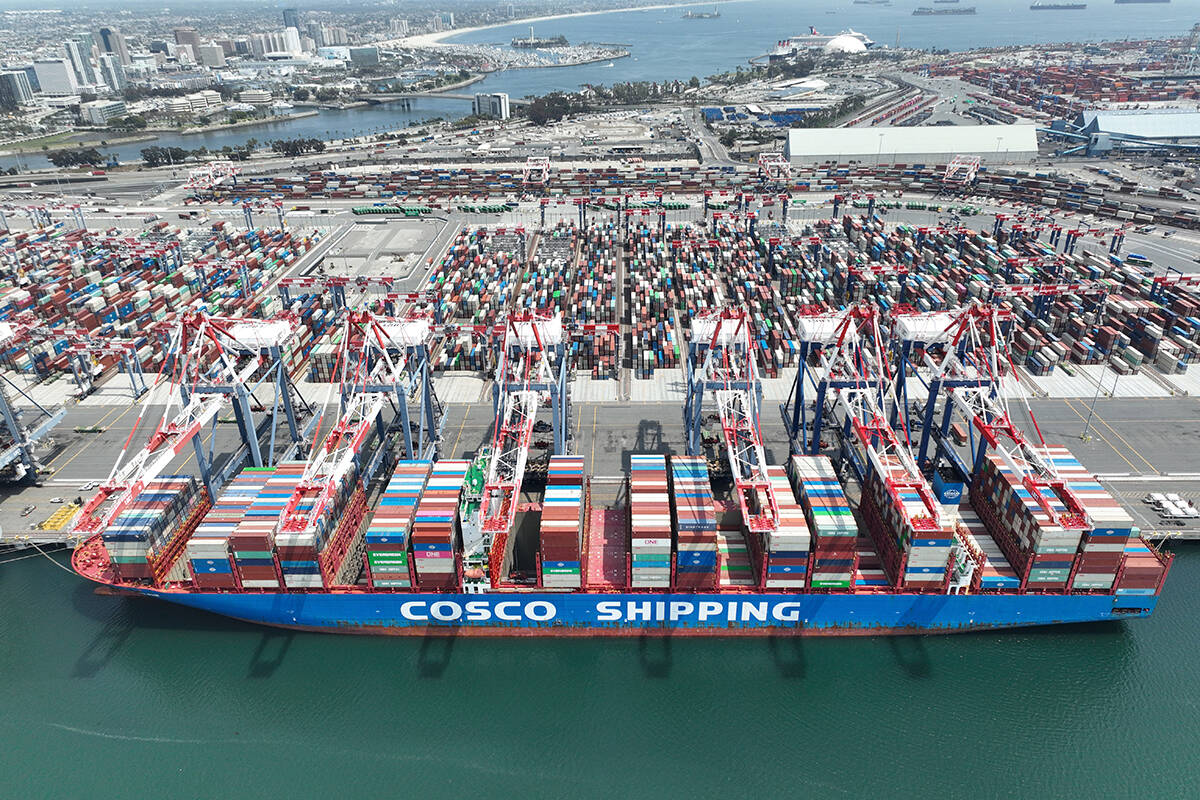Canola’s recent rise to a record high above $1,060 per tonne in the November contract was driven by its short supply but also by a weaker Canadian dollar and surprising strength in soy meal.
The peak was reached Nov. 12 and values have since edged back, particularly since the severe rainfall in British Columbia washed out parts of the main lines of both of Canada’s transcontinental railways.
In recent weeks, the two railways have been shipping an average of about 160,000 tonnes of canola per week to Vancouver terminals, part of a total of an average of about 480,000 tonnes of all grains.
Read Also

U.S. softens fees on Chinese shipping
The U.S. starts charging new fees on Chinese ships on Oct. 14. What are the ramifications for their ag exports?
Even with Western Canada’s drought-reduced crop limiting the export pace, extended rail outages would have a significant impact on prices.
Late on Nov. 19, Canadian Pacific Railway stated that with repair crews working around the clock, service on that line would be restored by about Nov. 24, barring unforeseen difficulties.
If the infrastructure can be repaired quickly then canola price movements will again be influenced by the global oilseed and crude oil markets and currency fluctuations.
The soybean complex has recently seen the hot soy oil component cool, but strengthen in soymeal.
Previously, the oil component had been the price driver as supply of competing canola oil tightened and the price of crude oil soared, with West Texas crude peaking in late October and early November near US$85 a barrel.
But crude has since fallen about $5, as China and the U.S. last week discussed opening strategic reserves.
Also, COVID-19 cases in Europe are sharply rising again, fuelling worries of renewed partial lockdowns and travel restrictions that would lessen crude demand.
The cooling of the crude market spilled over into the vegetable oil sector. The Chicago December soy oil contract peaked in late October near US65 cents per pound, but last week was trading around 59.5 cents.
But concurrently, the soy meal market came alive, climbing to its highest level since early July, propelled by strong demand for soymeal in Canada because of the feed shortage and also shortages of dry lysine. A significant amount of dry lysine comes from China and shipments are held up by the West Coast port congestion. Feeders are forced to replace lysine with more soymeal.
The drop in crude oil prices also affected the Canadian dollar because of the significant role petroleum production and exports have in the economy. A weaker loonie tends to lift canola prices.
The loonie traded near US81 cents in late October, but last week was down near 79 cents.
The loonie, like other currencies, also gave ground to the U.S. dollar as traders noted rosy economic news. October U.S. retail sales were stronger than expected and home construction was strong. Also, U.S. job creation was stronger than expected in October and wages were increasing.
This increased expectations that the U.S. Federal Reserve might end asset purchases earlier than forecasted and raise rates as early as the beginning of 2022.
Crude oil might be down now, but it is not likely to fall much and might even rally again.
U.S. oil producers are not rushing to rebuild production that remains about 12 percent below the pre-pandemic high. They are enjoying high profits and using the money to pay down debt and restore dividends to investors.
The Organization of Petroleum Exporting Countries is also reluctant to rebuild output beyond its agreed upon rate of 400,000 barrels a month.
Oil producers around the world are shy about pouring money into production when forecasters such as the International Energy Agency says “a reprieve from the price rally might be on the horizon,” noting that OPEC and U.S. production increases might be slow but they are steady, and also production problems in the Gulf of Mexico because of Hurricane Ida have been resolved.
The IEA, OPEC and the U.S. Energy Information Administration all forecast that the production deficit will shift to a surplus next year, so long as OPEC members hit their production increase targets. But alas, they have repeatedly failed to hit their targets in recent months.
So the future price direction of crude remains an open question.
Oilseed market traders are also watching South American growing conditions.
Brazil’s soybean seeding is more than 75 percent complete, faster than usual, and moisture conditions are good in the north and central region but dry in the south. The south was expected to continue dry into December. If it remains dry in January when soy pods are filling, it could trim yield potential.
Argentina’s soy planting was a bit behind normal but recent rain helped seedlings get started. Still, the La Nina that might lead to dry weather in coming months remains a worry.

















